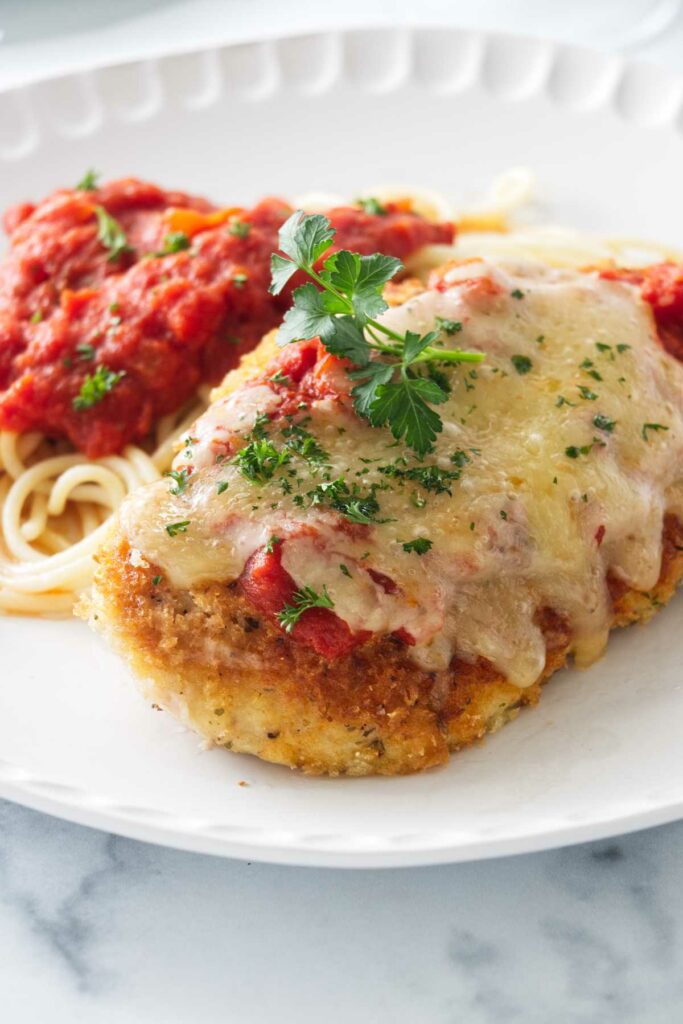Chicken Parmesan a Classic Comfort Dish for Every Occasion is a delicious recipe that combines amazing flavors and textures.
Chicken Parmesan stands as one of the most beloved Italian-American dishes, combining crispy breaded chicken with tangy marinara and melted cheese in perfect harmony. This comfort food classic manages to feel both celebratory and everyday, equally at home on weeknight dinner tables and special occasion spreads. Its universal appeal lies in the perfect balance of textures and flavors – crispy, tender, saucy, and cheesy all in one bite.
Despite its restaurant-quality presentation, Chicken Parmesan is surprisingly approachable for home cooks. The techniques involved – breading, pan-frying, and baking – are fundamental skills that yield impressive results. The dish also welcomes customization, allowing cooks to adjust sauces, cheeses, and seasonings to personal preference while maintaining its essential character.
Historical Context
Chicken Parmesan (or Parmigiana) has roots in Southern Italian cuisine, specifically the eggplant Parmigiana tradition. When Italian immigrants came to America, they adapted the dish using more readily available proteins like chicken and veal. The addition of pasta as a side likely emerged in American restaurants as a way to create more substantial meals.

The dish gained popularity in mid-20th century Italian-American restaurants and eventually became a staple of family dinners across the country. Its appeal crosses regional and cultural boundaries, making it one of the most successful fusion dishes in American culinary history. Today, it represents the perfect marriage of Italian technique and American abundance.
Selecting Ingredients
Chicken: Breast halves pounded to even thickness ensure consistent cooking. For more flavor, use chicken thighs, though cooking time may need adjustment. Proper pounding not only tenderizes the meat but creates the ideal surface area for coating.
Cheese: Fresh mozzarella provides superior meltability, while low-moisture mozzarella offers more pronounced flavor. A combination often works best. Freshly grated Parmesan (not the canned powder) makes a significant difference in both the coating and topping.

Sauce: Quality marinara is essential. While homemade sauce is ideal, many excellent jarred versions work well for convenience. Look for sauces with simple ingredients and no added sugar.
Breadcrumbs: Italian-seasoned breadcrumbs are convenient, but plain breadcrumbs allow you to control seasoning. Panko breadcrumbs create an extra crispy coating that holds up well under the sauce.
Technique Mastery
Pounding Chicken: Place chicken between plastic wrap or parchment paper and pound from the center outward. Even thickness prevents uneven cooking where thin parts overcook while thick parts remain underdone.
Breading Station: Use one hand for dry ingredients and the other for wet to avoid clumpy fingers. Let the breaded chicken rest for 10-15 minutes before cooking to help the coating adhere during frying.
Frying: The oil should be hot enough that a breadcrumb sizzles immediately but not so hot that the coating burns before the chicken cooks through. Don’t overcrowd the pan, which lowers oil temperature and causes steaming.
Baking/Broiling: The final melting under the broiler should be brief – just until the cheese melts and browns slightly. Overcooking at this stage can make the chicken dry and the coating soggy.
Sauce Considerations
The sauce should complement rather than overwhelm the chicken. A light layer on each breast provides moisture and flavor without making the coating soggy. Reserve additional sauce for serving alongside the pasta.
If using jarred sauce, consider enhancing it with fresh garlic, basil, or a pinch of red pepper flakes. Simmering the sauce briefly before using helps concentrate flavors and evaporate excess water that could make the coating soft.
Pasta Pairing
Spaghetti is traditional, but any pasta shape works. Cook pasta al dente as it will continue to soften under the sauce. Tossing the pasta with a little sauce before plating prevents sticking and ensures every strand is flavorful.
For a lighter alternative, serve with zucchini noodles or a simple green salad. The chicken is substantial enough to stand on its own without pasta for those preferring lower-carb options.
Modern Variations
While classic Chicken Parmesan remains beloved, creative variations have emerged. Some cooks add prosciutto or fresh basil under the cheese layer. Others use different cheeses like fontina or provolone for more complex flavor profiles.
Health-conscious versions might bake instead of fry the chicken, though texture differs significantly. For gluten-free diets, use almond flour and gluten-free breadcrumbs. Vegetarian versions using eggplant or tofu follow the same preparation method.
Wine Pairings
The rich, tomato-based dish pairs beautifully with medium-bodied Italian reds like Chianti Classico or Barbera. The acidity in these wines cuts through the richness while complementing the tomato sauce. For white wine lovers, a full-bodied Pinot Grigio or Vermentino stands up to the dish’s flavors.
For non-alcoholic options, sparkling water with lemon or an Italian soda provides refreshing contrast. Iced tea, either sweetened or unsweetened, also complements the meal well.
Serving and Leftovers
Serve Chicken Parmesan immediately after broiling while the cheese is still stretchy and the coating crisp. Garnish with fresh basil or parsley for color and freshness.
Leftovers reheat surprisingly well in the oven or air fryer (not microwave, which makes the coating soggy). The chicken can also be cooled completely and frozen for up to 3 months, then reheated directly from frozen in a 350°F oven.
Final Thoughts
Chicken Parmesan represents the best of comfort food – familiar yet special, simple yet sophisticated. Its enduring popularity speaks to its ability to satisfy on multiple levels: texturally, visually, and emotionally. Whether cooking for family or entertaining guests, this dish rarely fails to impress and comfort simultaneously.
As you enjoy the crispy, cheesy, saucy goodness, appreciate how this dish embodies the immigrant experience – adapting old world techniques to new world ingredients to create something uniquely delicious. Chicken Parmesan isn’t just food; it’s edible history that continues to evolve while staying true to its comforting essence.

Chicken Parmesan a Classic Comfort Dish for Every Occasion
Ingredients
Method
- Place chicken between plastic wrap and pound to even thickness.
- Set up three shallow dishes: flour seasoned with salt/pepper, beaten eggs, and breadcrumbs mixed with Parmesan and Italian seasoning.
- Dredge each chicken breast in flour, then egg, then breadcrumb mixture, pressing to adhere.
- Heat olive oil and butter in large oven-safe skillet over medium heat.
- Cook chicken for 4-5 minutes per side until golden brown and cooked through.
- Remove from skillet and drain on paper towels.
- Preheat broiler.
- Return chicken to skillet and top each breast with marinara sauce.
- Add mozzarella cheese and sprinkle with Parmesan.
- Broil for 2-3 minutes until cheese is melted and bubbly.
- Serve chicken over cooked spaghetti with additional sauce.
- Garnish with fresh basil leaves.



